Can You Change Golf Balls During A Hole
Can You Change Golf Balls During a Hole? Most of the time, you cannot change your golf ball while playing a hole. The USGA rules say you have to keep using the same ball until the hole is finished. But there are some exceptions.
You can switch if your ball is damaged, lost, or if you’re taking relief. This is part of Rule 14.3 and 4.2c. If you change balls without a good reason, you might get a penalty, like two extra strokes or even lose the hole.
Even on the putting green, you can only mark and replace the same ball, not a new one. Learning these rules helps you play the game the right way and avoid mistakes.
Table: When Can You Change Golf Balls During a Hole
| Situation | Can You Change the Ball? | Rule Reference | Explanation |
| The ball is lost or out of bounds | Yes | Rule 14.3c | You must take stroke-and-distance relief, so a new ball is allowed. |
| Ball is cut or cracked (physically damaged) | Yes | Rule 4.2c | You may substitute a new ball if the original is visibly cut or cracked. |
| The ball is scuffed, dirty, or scratched | No | Rule 4.2c | Surface marks or mud don’t qualify as damage. You must play the same ball. |
| Taking free relief (e.g., from the cart path) | Yes | Rule 14.3b | Relief allows you to use a new ball if you choose. |
| Taking penalty relief (e.g., water hazard) | Yes | Rule 14.3c | You are allowed to switch balls while taking penalty relief. |
| On the putting green (marked ball) | No (must use the same ball) | Rule 14.1c | You may clean the ball, but you must replace the same one. |
| Accidentally damaged during play | No | Rule 4.2c(1) | If the player caused the damage, the ball may not be replaced. |
| Damaged by outside influence (e.g., mower) | Yes | Rule 14.2d(2) | If a ball is damaged by outside forces, it can be replaced. |
| Switching to a different model for putting | No | One Ball Rule | In competitive rounds, players cannot switch models unless allowed by the rules. |
Note: This table summarizes the legal and illegal situations for changing a golf ball mid-hole based on the USGA Rules of Golf.
When Are You Allowed to Change Golf Balls During a Hole Under USGA Rule 14.3
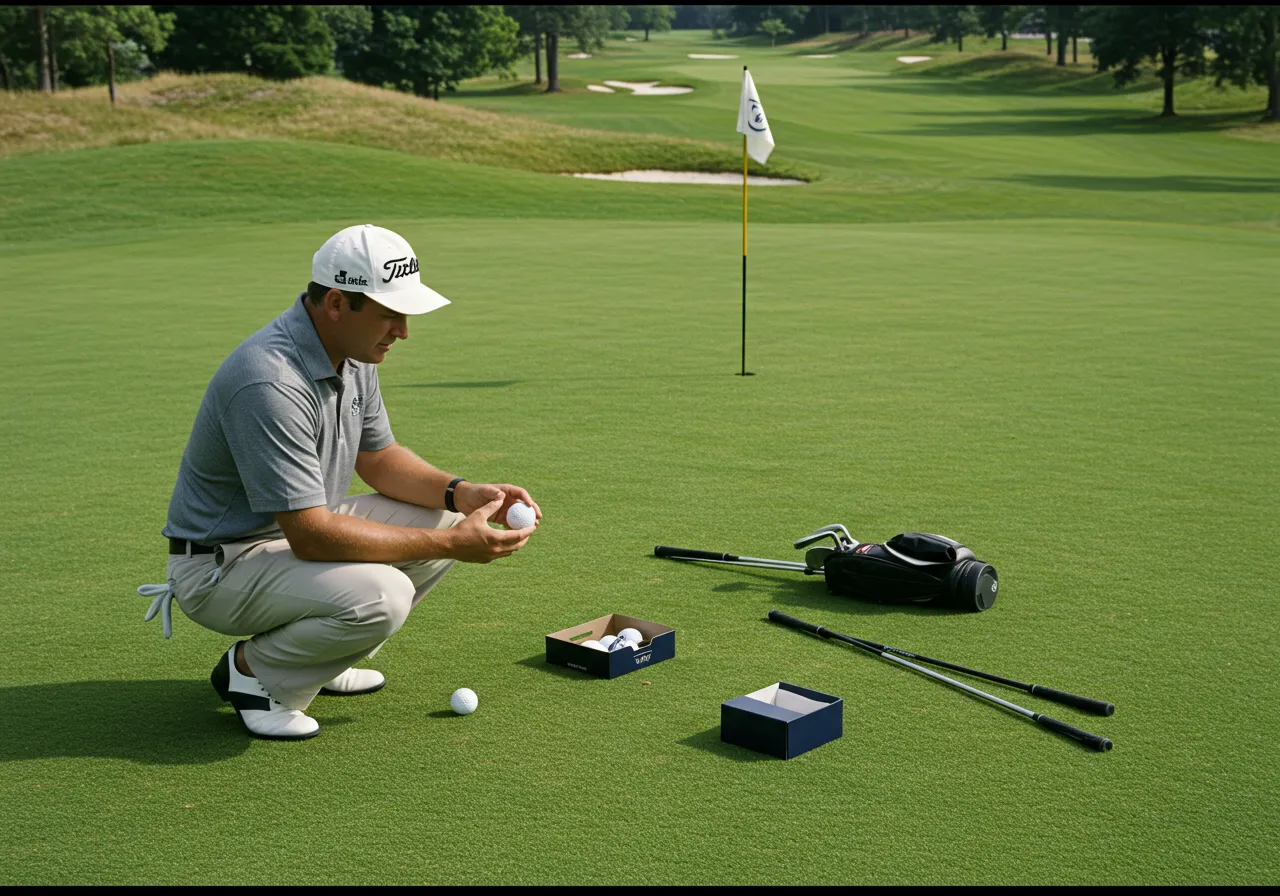
There are only a few times you’re allowed to use a new ball during a hole:
- If your ball is lost or goes out of bounds
You must take a new ball when you go back to replay your shot with a penalty. - If your ball is visibly damaged (cut or cracked)
Not all damage counts. It has to be real physical damage, not just a scuff or dirt. - If you are taking relief
This means a drop from a water hazard, cart path, or an unplayable spot. In those situations, you’re allowed to change balls while taking relief.
In a recent tournament, I had to drop because my ball was up against a fence. Since it was a relief situation, I was allowed to use a new ball. If it wasn’t, I would’ve had to play the original.
Can You Change Golf Balls on the Putting Green if It Is Dirty or Scuffed
No, you are not allowed to switch to a different golf ball just because your ball is dirty.
The USGA Rule 4.2c says that a ball must be cracked or cut to be replaced. Dirt, mud, or minor marks do not count as damage.
If you’re on the green and the ball is marked, you can clean it, but you still have to put the same ball back in place.
Many players think they can quietly switch to a better ball for putting, but that is against the rules.
What Is the Penalty for Switching Golf Balls Without Permission During a Hole
If you change your golf ball when you’re not supposed to:
- In stroke play, you will receive a two-stroke penalty.
- In match play, you automatically lose the hole.
This is called a Wrong Ball penalty. It falls under the category of breaking the equipment substitution rule.
I’ve seen players lose a good round just because they made this mistake. Following this rule saves you from big setbacks.
Why Learning the Rules About Changing Golf Balls Helps You Play Better

Knowing when you can and cannot switch balls is a small detail, but it has a big effect.
If you are playing in a tournament or even just a friendly game, you should always play by the rules. It keeps the game fair and helps you avoid unexpected penalties.
I always double-check my ball before the hole starts. If it’s in good shape, I keep it.
Once the hole begins, I only change it if I know the rules allow it, like after relief or if it’s clearly damaged. That’s what being a smart golfer is all about.
When Are You Allowed to Change Golf Balls During a Hole According to USGA Rules
This is something I’ve had to learn through real game experience, and honestly, knowing when you’re allowed to switch balls can save you strokes and help you avoid big penalties.
Let me break down the legal times you’re allowed to change a golf ball during a hole, based on USGA Rule 14.3 and Rule 4.2c.
Changing Your Golf Ball When It Is Cut or Cracked (Damaged Ball Rule Explained)
If your golf ball gets cut or cracked, for example, by hitting a cart path, a tree, or even a sharp rock, you are allowed to change it. But it’s not enough to say, “It doesn’t feel right.” The damage has to be real and visible.
- The cut or crack must be seen clearly.
- In tournaments, a rules official or opponent might have to confirm it.
- If it’s just dirty, scratched, or scuffed, you must keep playing the same ball.
I once had a drive hit the edge of a bunker and come back with a chunk missing. That’s the kind of damage where you can legally switch it out. But if it’s just mud? Clean it and keep playing.
Using a New Golf Ball After Losing Your Original or Hitting Out of Bounds
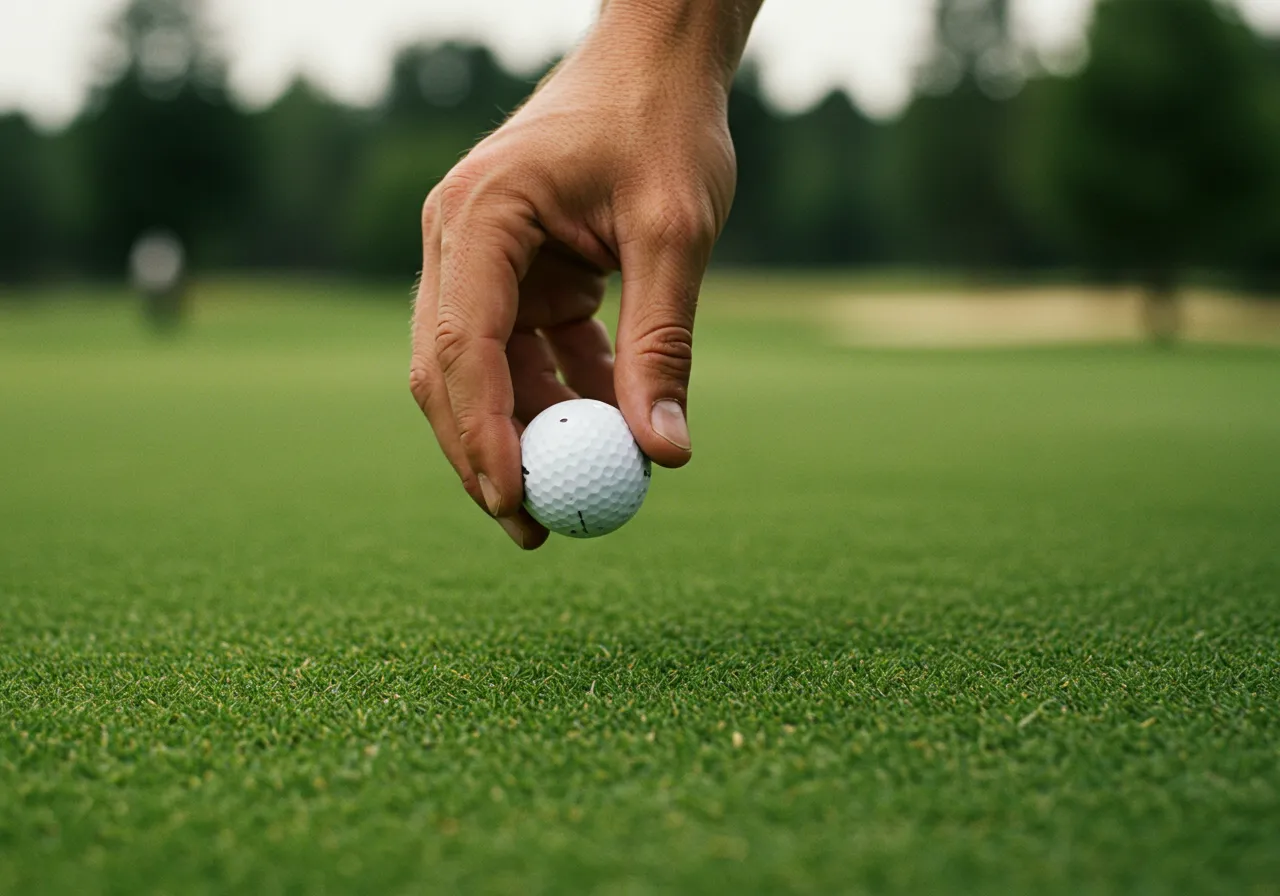
If your ball is lost or goes out of bounds, you’re allowed to use a new ball. This is because you must take stroke-and-distance relief, which means going back and playing the shot again with a one-stroke penalty.
You can also use a provisional ball, which is a backup ball in case your first one is lost. Once you confirm the first ball is gone, the provisional becomes the ball in play.
This rule has saved me more than once. If there’s any chance your shot went into trouble, hit a provisional right away so you don’t waste time or risk breaking a rule.
Replacing a Golf Ball During Relief Procedures Like Penalty Drops
Sometimes your ball lands in a penalty area, on a cart path, or in a place where you declare it unplayable.
These are called relief situations. In these cases, when you drop the ball under the rules, you’re allowed to switch to a new ball if you want.
This is totally legal, and I often take advantage of it. If the old ball is dirty or scuffed, it’s a great time to use a fresh one.
Switching Golf Balls After Finishing a Hole (Between-Hole Ball Change Rule)
Once you finish a hole by holing out, you’re always allowed to start the next hole with a different ball, even a different model or brand.
There’s no rule stopping that in casual rounds. Just be careful in tournaments if the one-ball rule is in effect, which requires using the same ball model throughout the round.
For me, I usually stick to the same type of ball during a round for consistency, but if I want to switch between holes, the rules allow it.
What Happens If You Change Golf Balls in the Wrong Way During a Hole
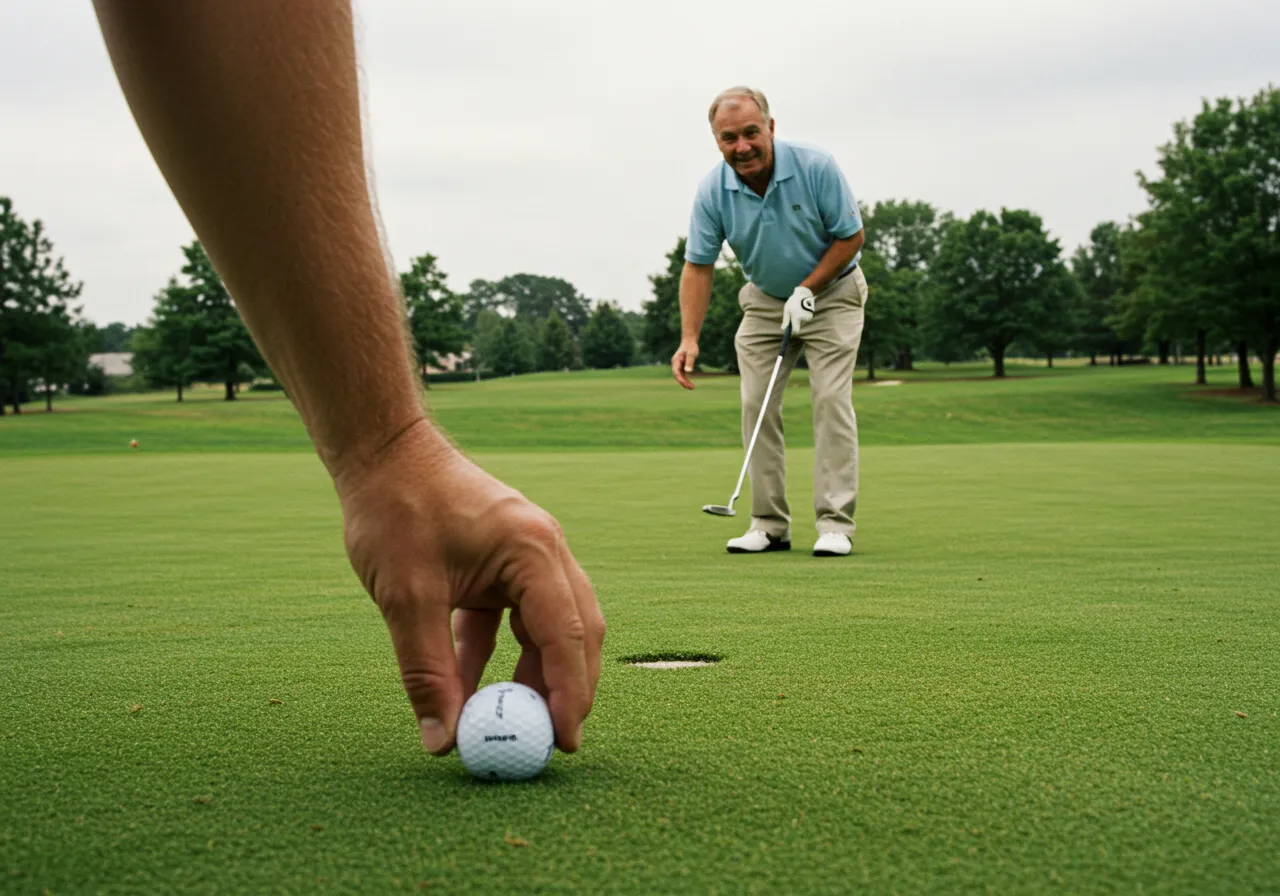
Changing your golf ball at the wrong time can lead to a serious penalty, even if you didn’t mean to break the rules.
I’ve played enough tournament rounds to know that if you don’t follow Rule 6.3c, you could lose a stroke or even the hole.
Let’s look at some common illegal mistakes players make, and what penalties you’ll get if you do them.
Is It Illegal to Change Your Golf Ball Because It Is Dirty or Feels Bad
Yes, it’s against the rules. If your ball is just muddy, scratched, or you think it’s “not spinning right,” you cannot switch it mid-hole.
One time, a player in my group asked if he could change his ball because it felt “off” on his putter.
I had to remind him that unless it’s cut or cracked, the rules say no. He cleaned the ball and kept going.
Can You Use a Different Golf Ball on the Putting Green for More Spin
No, that’s also not allowed. You cannot say, “I’ll use this softer ball to putt better,” and swap it out on the green.
Even though you are allowed to mark and lift your ball on the green, you must replace the exact same one. Trying to get a better spin by changing balls is a rules violation.
What Is the Penalty for Switching Balls Illegally During a Hole
If you break the rules and switch your ball without permission, here’s what happens:
| Format | Penalty |
| Stroke Play | 2 strokes added |
| Match Play | Lose the hole |
These penalties fall under the Wrong Ball Rule. I’ve seen players disqualified from school matches just for using a different ball to finish the hole. It’s a simple mistake that can ruin your round.
How to Avoid Wrong Ball Penalties Like a Pro
Here’s my best advice from experience:
- If your ball is just dirty, clean it, don’t replace it.
- If you’re on the green, mark and return the same ball.
- Never switch to a different brand or model mid-hole for a better feel or spin.
- Only change balls when allowed by relief rules or visible damage.
Knowing these details not only helps you avoid penalty strokes, but it also shows you respect the game.
Can You Change Your Golf Ball on the Putting Green During a Hole
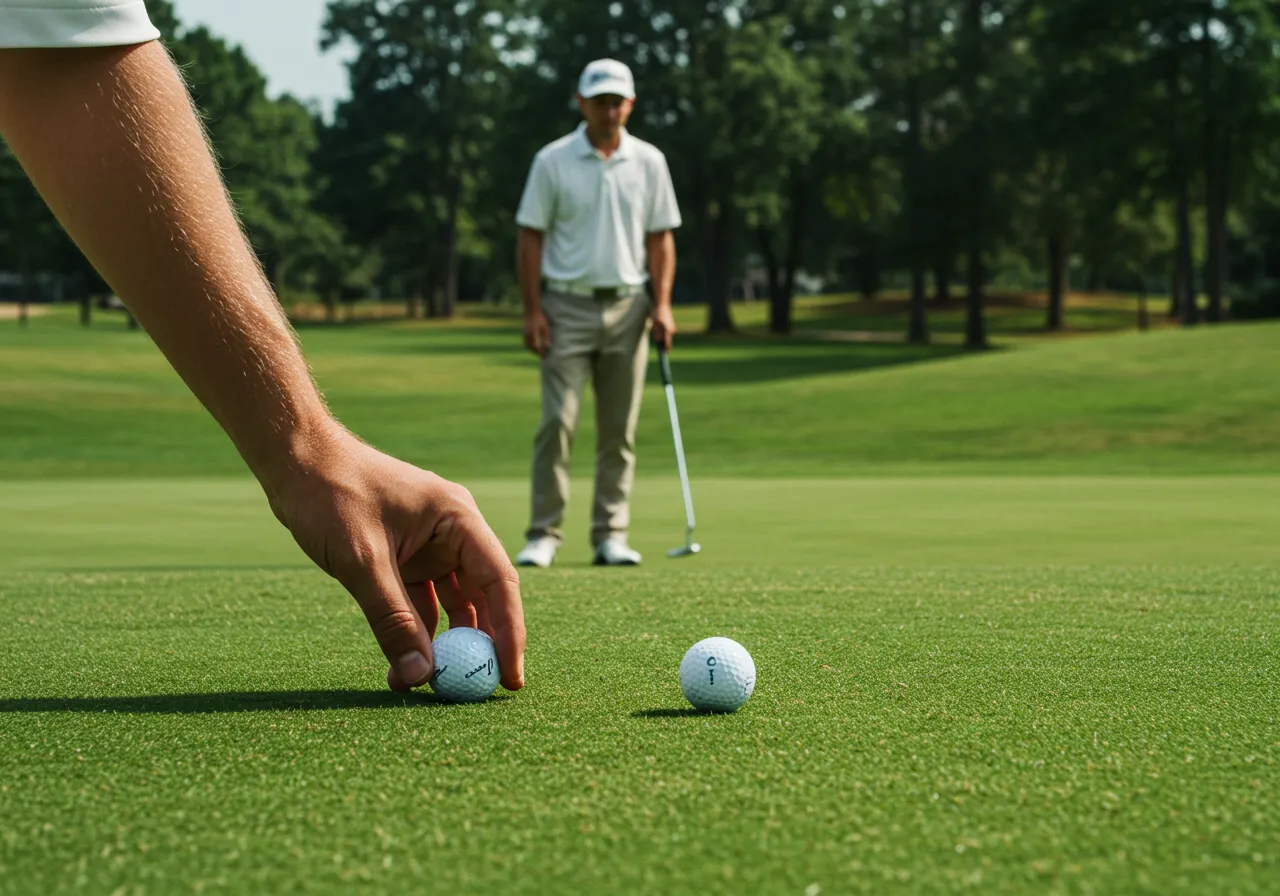
Many golfers, especially new players, think they can just switch to a cleaner or softer ball when they get on the green.
But that’s not allowed under the USGA rules, and I’ve seen penalties happen because of this exact mistake. Let’s break down what’s legal and what’s not when you’re putting.
Are You Allowed to Change Golf Balls While Putting on the Green
No, you are not allowed to change your ball on the green unless it’s clearly damaged. This is a strict rule under the USGA’s guidelines.
Just because your ball is dirty or you want more spin, that’s not a good enough reason.
You have to keep using the same ball that you hit onto the green, unless it’s cut or cracked.
I once saw a player switch to a different ball just before putting because he liked the feel of it better. It cost him two penalty strokes in stroke play.
He had no idea he was breaking a rule, but the USGA doesn’t make exceptions for “preference.”
What Are You Allowed to Do With Your Golf Ball on the Green
You can mark your ball with a coin or marker, lift it, clean it, and then put it back in the exact same spot.
That’s totally legal and something I do all the time when my ball has dirt on it.
But here’s the key: You must replace the same ball. No switching it out unless it’s confirmed to be damaged under Rule 4.2c.
When Can You Legally Replace a Damaged Ball on the Green
Suppose your ball is visibly damaged, like cracked or cut, even while on the green, you are allowed to replace it. The replacement must be the same model and make as the original.
This happened to me once when my ball rolled into a sprinkler head and came out with a visible gash.
I showed it to my playing partner, and we agreed it was damaged. I got to switch it without penalty.
Why You Should Never Switch Balls on the Green Unless the Rules Allow It

Changing your ball just because it “feels better for putting” is a rules violation. It doesn’t matter if it’s the same brand or a softer version. If the original ball isn’t damaged, you must putt with it.
Stick to one ball throughout the hole unless the rules about relief or damage apply. It keeps your score clean and shows respect for the game.
Table: Changing Golf Balls on the Putting Green – What’s Allowed and What’s Not
| Action or Situation | Allowed? | Rule Reference | Explanation |
| Marking and lifting your ball on the green | Yes | Rule 14.1c | You can mark your ball with a coin or marker before lifting it. |
| Cleaning the ball after lifting it on the green | Yes | Rule 14.1c | It’s legal to clean the ball after marking and lifting it. |
| Replacing the same ball in the same spot | Yes | Rule 14.1c | You must replace the same ball in the exact place it was marked. |
| Changing to a new ball for putting because it’s cleaner | No | Rule 14.1c | You cannot switch balls just for personal preference or cleanliness. |
| Switching to a softer ball for better spin on the green | No | Rule 14.1c | Changing balls for a better feel or spin is not allowed. |
| Replacing a ball that is cut or cracked | Yes | Rule 4.2c(1) | If your ball is visibly damaged, you can use a new ball of the same make and model. |
| The ball has only scratches, scuffs, or dirt | No | Rule 4.2c(2) | Cosmetic wear is not enough to allow ball replacement. |
| Forgetting which ball you used and placing a different one | No | Rule 6.3c | Replacing a different ball by mistake counts as playing the wrong ball. |
| Playing a second ball “just to try a putt” on the green | No (unless the stroke is canceled) | Rule 20.1c(3) | In casual play, this might happen, but in competition, it could result in a penalty. |
| Replacing a ball damaged by outside forces (like a mower) | Yes | Rule 14.2d(2) | If damage is caused by something external, you may replace the ball without penalty. |
Note: This table gives a clear and simple breakdown of when you can and cannot change golf balls on the putting green. It follows current USGA rules and helps all players understand how to follow the rules and avoid unnecessary penalties.
Do PGA Tour Players Have to Use the Same Golf Ball for the Entire Round
If you’ve ever watched a professional tournament, you might wonder, “Can PGA players switch golf balls during a round?” The answer is no, not freely.
In PGA events, we have to follow something called the One-Ball Rule, also known as Model Local Rule G-4. This rule is strict, and if you break it, you’re disqualified.
What Is the One-Ball Rule in Professional Golf Competitions
The One-Ball Rule means that a player must use the same brand and model of golf ball for the entire round.
So if you start your round with a Titleist Pro V1, every ball you use during that round must also be a Titleist Pro V1, no switching to a different model or brand for spin or feel.
This rule is part of the conditions of competition and is standard in PGA Tour events.
I’ve had to list the exact ball I’m using on my scorecard at some events just to stay in line with the rules.
What Happens If a Pro Golfer Breaks the One-Ball Rule During a Round
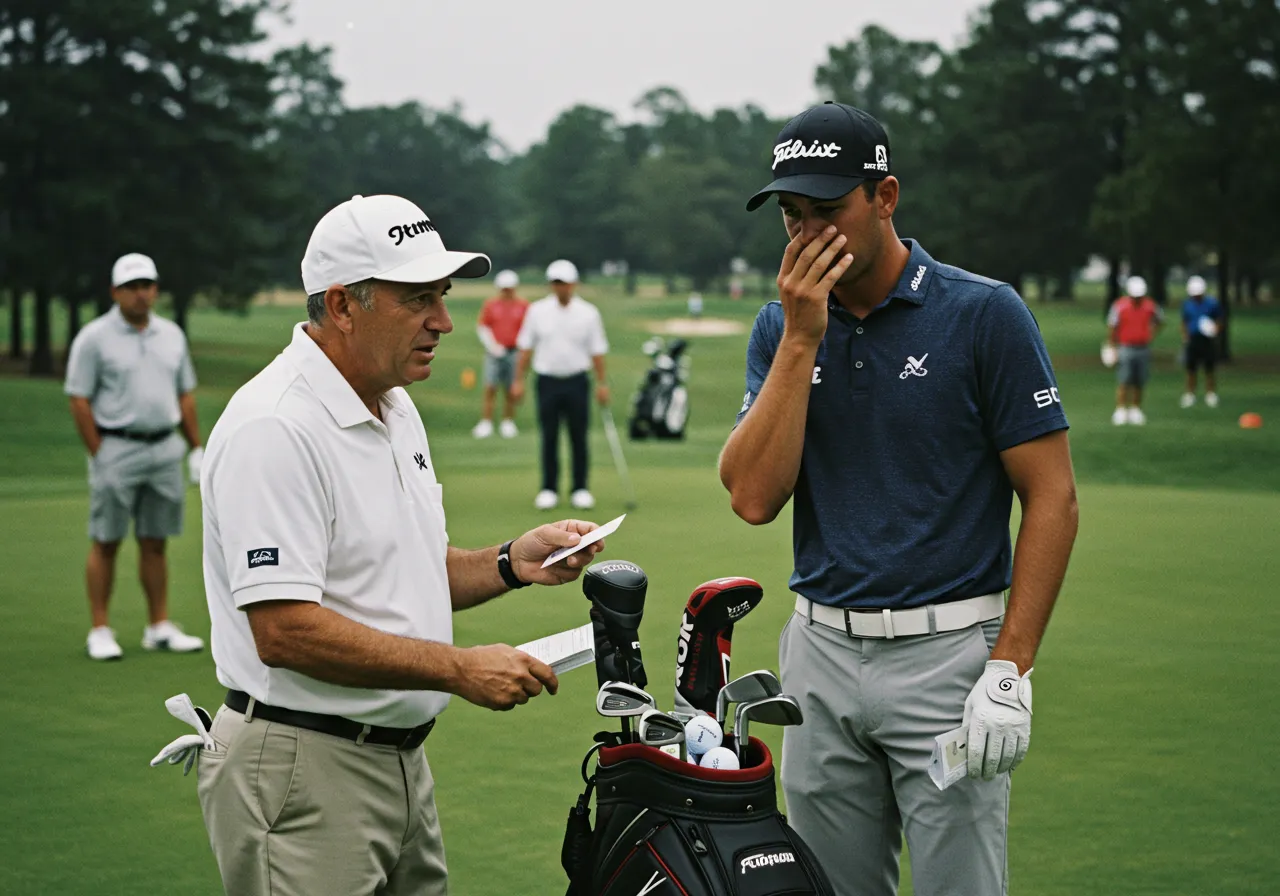
If you switch to a different model or brand without permission, the punishment is serious: disqualification from the tournament. No warnings.
No second chances. That’s why every pro I know takes this rule seriously. We carry several identical backup balls just in case one gets lost or damaged.
When Are PGA Players Allowed to Change Golf Balls During a Round
As pros, we are allowed to change balls only after finishing a hole, and the new ball must be the same make and model.
During a hole, we can switch balls only if it is cut, cracked, or lost, following the USGA relief rules.
Personally, I never switch unless I absolutely have to. Even a slightly different ball can feel off and mess with my control, especially on approach shots or putts.
Why Using the Same Ball Model Matters for Pro Performance
Every golf ball model reacts a little differently; some spin more, some fly farther, some feel softer off the putter.
In professional play, consistency is everything. That’s why the One-Ball Rule helps keep the game fair and the results based on skill, not equipment changes.
What Are the Best Golf Ball Etiquette Tips for Amateurs During a Round
If you’re just starting out or playing casual golf, you may not be following strict PGA rules, but there’s still a right way to handle your golf ball.
Over the years on the course, I’ve learned that knowing when to clean, when to inspect, and when to switch makes a huge difference in your game and how others see you as a player.
Should Amateur Golfers Change Golf Balls During a Hole or Just Clean Them
In casual golf, it’s best to avoid switching balls during the hole unless it’s truly needed. Instead of reaching for a new one, try this first: mark your ball, lift it, and clean it.
Most of the time, dirt or grass is the only problem, not real damage. I always carry a towel and a brush in my bag just for this reason.
Not only does cleaning keep your ball in good shape, but it also shows proper golf etiquette.
When Should You Inspect Your Golf Ball for Damage in a Round
After you hit a cart path, a tree, or a rocky area, take a moment to check your ball carefully.
Look for real signs of damage like cracks, deep cuts, or chunks missing. If it’s only scratched or scuffed, the rules say you must keep using it.
During a junior match I coached, a player replaced their ball after a tree hit it just because it looked worn.
Unfortunately, that cost them a two-stroke penalty because the damage wasn’t enough to allow a switch. Learn to check, not guess.
Are Refurbished Golf Balls a Good Idea for Casual Rounds
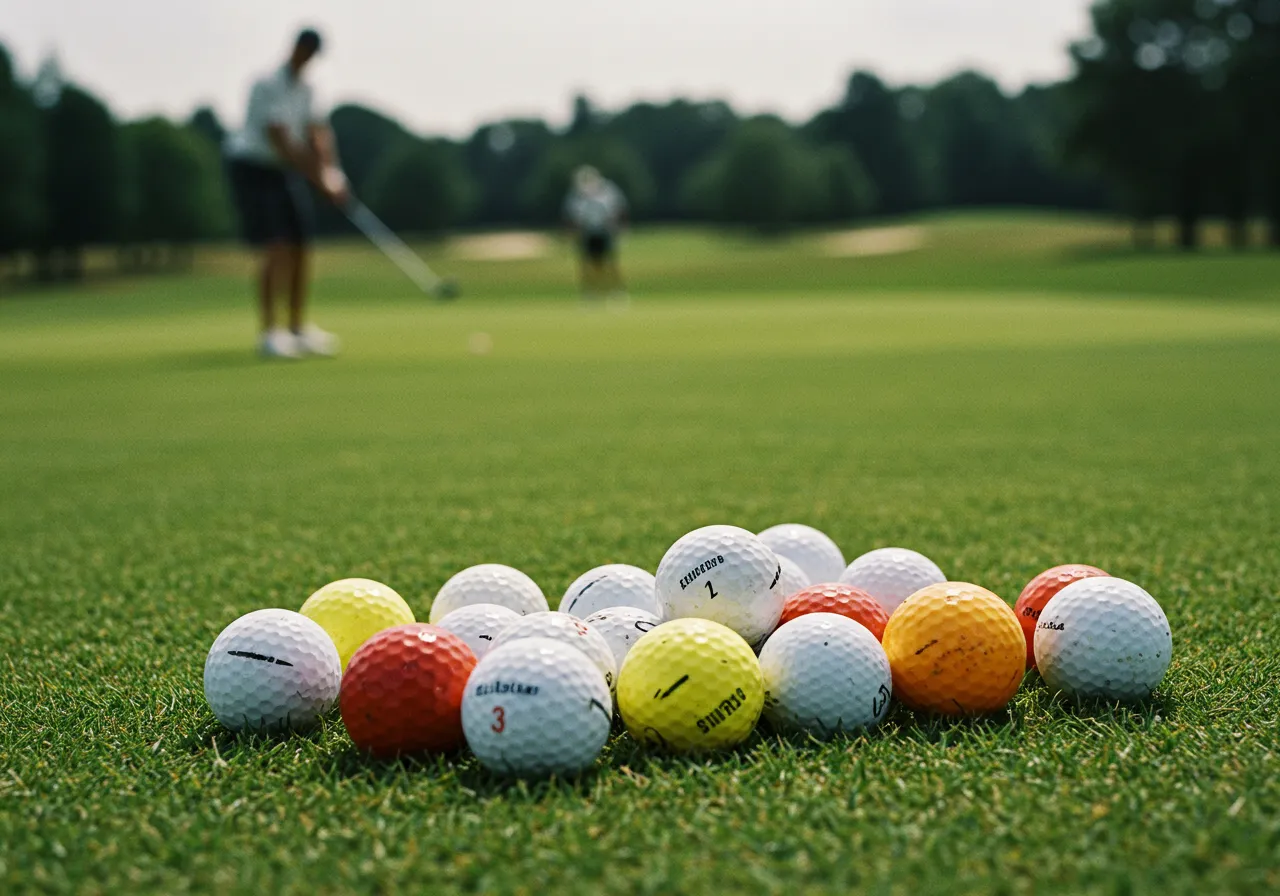
Refurbished or used balls can be great for saving money, but be careful. Sometimes they look fine on the outside but have hidden damage that can cause inconsistent performance.
I’ve had refurbished balls feel completely different on approach shots, even when they looked identical.
So if you’re using recycled or used balls, check them before every hole.
A ball with internal damage can mess up your swing results and make it hard to know if your mistake was the ball or your shot.
Pro Tip: Be Smart, Be Fair, and Play the Ball Right
If you’re a beginner or playing in a local tournament, respect the rules and other players.
Stick to one ball per hole when possible, clean it when needed, and replace it only if the damage is real. That’s how you build confidence, skill, and a good name on the course.
What Are the 2024 Golf Ball Rule Updates and Do They Affect Ball Switching
A lot of golfers I meet, especially younger players, ask me about the new 2024 golf ball rules.
There’s been a lot of talk about distance limits and colored balls, but it’s important to know which changes do and don’t affect ball substitution during a round.
Let me break it down from a pro’s point of view.
Does the 2024 Golf Ball Rollback Rule Affect When You Can Change Balls
No, it doesn’t. The 2024 golf ball rollback rule is all about how far golf balls can travel, especially at higher swing speeds.
It was made to stop long hitters from overpowering certain courses. But it has nothing to do with the rule about changing balls during a hole.
In simple terms, the rollback changes the design and distance of some balls in the future; it doesn’t affect when or why you can switch balls in a round.
I’ve tested some of these new balls, and they feel almost the same, but they go a little shorter for high-speed swings. For most casual players, you won’t even notice a big difference.
Can You Use Colored Golf Balls in the PGA or During Competitive Play

Yes, you can. Under Rule 4.2a, colored golf balls are completely legal, even in PGA Tour events. The important thing is that you use the same model and brand throughout the round, especially if the One-Ball Rule is in effect.
So if you start your round with a yellow Titleist Pro V1, you can use yellow Pro V1s the whole round, but you can’t switch to a white Pro V1x or any other model once the round begins.
I’ve seen more pros use colored balls lately, especially in cloudy or low-light conditions. They’re easier to track in the air, and the rules say it’s fine, as long as it’s the same model.
The 2024 Rule Updates for Amateur Golfers
If you’re not playing at the elite level, the rollback rule won’t really affect you, and colored balls are fully allowed.
But the main rule still applies: you must follow the substitution rules, and never switch balls during a hole unless it’s lost, damaged, or you’re taking relief.
Focus on playing with one ball at a time, knowing your model, and sticking to it. That’s how you stay legal and consistent, just like the pros.
FAQs
Can you change golf balls on the same hole?
No, unless the original ball is lost, out of bounds, visibly damaged, or you’re taking relief under USGA Rule 14.3.
Can I change my golf ball during a round?
Yes, but only between holes. In tournaments that use the One-Ball Rule, you must use the same brand and model for the entire round.
Can you replace a damaged golf ball mid hole?
Yes, but only if the damage is visible and serious, like a cut or crack. Scuffs, dirt, or scratches are not enough under Rule 4.2c.
Can you change your golf ball during a game?
Yes, but only when allowed bythe rule, such as between holes, after a lost ball, or during relief. You cannot change balls during a hole without one of those reasons.
Can you change balls while putting?
No, unless the ball is visibly damaged. You can mark and clean it, but you must replace the same ball under Rule 14.1c.
What is the penalty for switching golf balls during a hole?
Two-stroke penalty in stroke play, or loss of hole in match play. This falls under the Wrong Ball Rule (Rule 6.3c).
Can I switch brands of golf balls during a round?
Yes, but only between holes. If the One-Ball Rule is in effect, you must use the same brand and model throughout the round.
Final Thoughts: Follow the Golf Ball Rules and Play With Confidence
Changing your golf ball during a hole might seem like a small thing, but according to the USGA Rules of Golf, it’s a big deal if you don’t follow the correct steps.
If you’re playing casually with friends or in a tournament, knowing the rules about when and how you can switch golf balls helps you avoid penalties and keeps the game fair.
If you’re ever unsure, ask a fellow player or look up the rule. Great golf isn’t just about skill—it’s about knowing the game, respecting the rules, and making smart choices on the course.
How To Play Two Golf Balls When Unsure About a Rule
Post Reference: